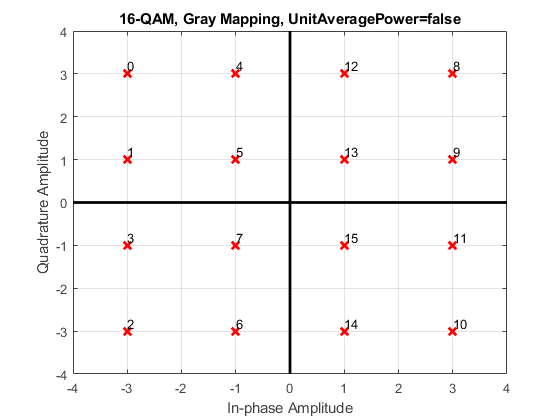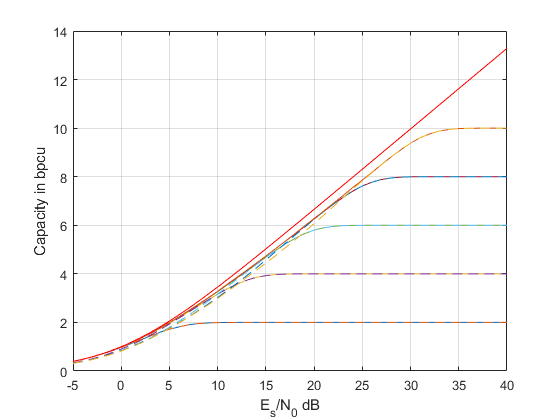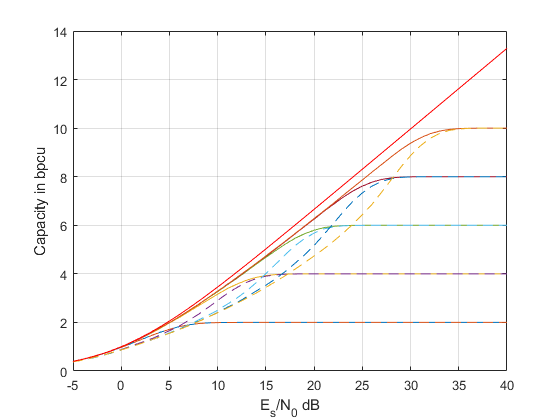Exemple Matlab : Systèmes BICM
Contents
2.6. Exemple Matlab : Systèmes BICM#
2.6.1. 1. Démodulation souple#
Soit \(\textbf{x}[n]=[x_1[n] \cdots x_m[n]]\) le vecteur binaire de \(m\) bits correspondant à l’étiquetage du symbole \(s[n]\) d’une constellation \(M\)-aire \(\mathcal{S},\) le log-rapport de probabilité est alors donné par
où \(\mathcal{S}_0^i\subset \mathcal{S}\) (resp. \(\mathcal{S}_1^i\)) est le sous ensemble des symboles \(s \in \mathcal{S}\) tels que le \(i\)-ième bit \(x_i[n]\) du vecteur \(x[n],\) tel que \(s[n]=\mathcal{}\) est le bit \('0'\) (resp. le \(i\)-ième bit \(x_i[n]\) du vecteur \(x[n]\) est le bit \('1'\)). \(p(s[n])\) est la probabilité a priori de \(s[n]\) qui sera considéré comme uniforme pour la plupart des cas d’intérêt.
Ns= 10; % Number of Symbols
Es_N0_dB = 10;
%loop for order M
M = [16]; % Constellation Order
Constellation=qammod((0:M-1)',M,'PlotConstellation', true);
BinaryTable=de2bi((0:M-1)','left-msb');
% Loop variable for SNR
% Monte carlo parameter
%generate M-QAM modulation
s = randi([0 M-1],1,Ns);
x = qammod(s, M);
Es_N0=10^(Es_N0_dB/10);%normal
sigx2=var(x);
N0 = sigx2 /(Es_N0);
%add noise
noise_ = sqrt(N0/2 )*randn(1,length(x))+ ...
1j*sqrt(N0/2 )*randn(1,length(x));
sig_rx = x + noise_ ;
%compute likelihood
xref=repmat(Constellation,1,Ns); %
d2=-abs((repmat(sig_rx,M,1)-xref)).^2/N0;
PYX=exp(d2)
%LLRs without a priori
LLRs=log((1-BinaryTable')*PYX)-log(BinaryTable'*PYX)
%Hard decisions
bhat=(1-sign(LLRs))/2
%bits
bits=de2bi(s,'left-msb')'
PYX =
0.0000 0.0000 0.0000 0.0000 0.0000 0.2226 0.0241 0.0000 0.0000 0.0000
0.0001 0.0000 0.0000 0.0000 0.0000 0.5733 0.0001 0.0000 0.0000 0.0000
0.0000 0.0000 0.5943 0.0000 0.0000 0.0000 0.0000 0.0000 0.0000 0.0000
0.0000 0.0000 0.0962 0.0000 0.0000 0.0007 0.0000 0.0000 0.0000 0.0000
0.0424 0.0000 0.0000 0.0000 0.0000 0.0028 0.7619 0.0000 0.0000 0.0000
0.2970 0.0000 0.0000 0.0000 0.0000 0.0073 0.0023 0.0000 0.0000 0.0000
0.0000 0.0000 0.0984 0.0071 0.0000 0.0000 0.0000 0.0000 0.0000 0.0000
0.0010 0.0000 0.0159 0.0141 0.0000 0.0000 0.0000 0.0000 0.0002 0.0001
0.0000 0.0000 0.0000 0.0000 0.0000 0.0000 0.0000 0.3149 0.0000 0.0000
0.0002 0.0000 0.0000 0.0000 0.0000 0.0000 0.0000 0.0163 0.0195 0.0008
0.0000 0.4640 0.0000 0.0050 0.6873 0.0000 0.0000 0.0000 0.0039 0.0588
0.0000 0.0004 0.0000 0.0100 0.0593 0.0000 0.0000 0.0000 0.3867 0.2994
0.0458 0.0000 0.0000 0.0000 0.0000 0.0000 0.0121 0.0001 0.0000 0.0000
0.3209 0.0000 0.0000 0.0005 0.0000 0.0000 0.0000 0.0000 0.0179 0.0007
0.0000 0.0048 0.0000 0.2643 0.0022 0.0000 0.0000 0.0000 0.0035 0.0528
0.0011 0.0000 0.0000 0.5297 0.0002 0.0000 0.0000 0.0000 0.3549 0.2687
LLRs =
-0.0774 -16.7382 11.3448 -3.6424 -19.1325 16.3323 4.1707 -23.4011 -8.4175 -8.4518
-7.5890 4.5664 1.7982 -3.9976 5.7672 4.3623 -3.4711 7.9029 0.0852 0.1077
5.7814 -21.8461 -11.3867 -7.3044 -12.5780 6.9771 19.1993 13.5678 -2.9975 -6.1464
-1.9504 7.1252 1.8208 -0.6963 2.4501 -0.9473 5.8007 2.9612 -4.6564 -1.6304
bhat =
1 1 0 1 1 0 0 1 1 1
1 0 0 1 0 0 1 0 0 0
0 1 1 1 1 0 0 0 1 1
1 0 0 1 0 1 0 0 1 1
bits =
1 1 0 1 1 0 0 1 1 1
1 1 0 1 0 0 1 0 1 1
0 1 1 1 1 0 0 0 1 1
1 0 0 0 0 1 0 0 1 1

2.6.2. 2. Capacité BICM#
On peut montrer la formule suivante, plus commode à utiliser et interpréter :
où \(I({X_k},{Y})=1-\mathbb{E}_{X_k,Y}{(\log_2(1+e^{-(1-2 X_k)L(X_k)}))}.\) \(I({X_k},{Y})\) est la capacité binaire associée au canal \(k\). Notons également que \(L(X_k)\) est une fonction implicite de \(Y.\) A partir de ces expressions, on peut alors facilement calculer une estimée
En général pour les modulations linéaires, le mapping de Gray permet d’être quasi-optimal pour les efficacités moyennes à grandes.
% Simulation parameters
Ns= 100000; % Number of Symbols
Es_N0_dB = (-5:40);
%loop for order M
for M = [4 16 64 256 1024]; % Constellation Order
Constellation=qammod((0:M-1)',M);
BinaryTable=de2bi((0:M-1)','left-msb');
% Loop variable for SNR
% Monte carlo parameter
for snr=1:numel(Es_N0_dB)
%generate M-QAM modulation
s = randi([0 M-1],Ns,1);
x = qammod(s, M);
Es_N0=10^(Es_N0_dB(snr)/10);%normal
sigx2=var(x);
N0 = sigx2 /(Es_N0);
%add noise
noise_ = sqrt(N0/2 )*randn(length(x),1)+ ...
1j*sqrt(N0/2 )*randn(length(x),1);
sig_rx = x + noise_ ;
%Compute Capacity
%%Entropy
Hx=log2(M);
%%Conditionnal Entropy
xref=repmat(Constellation,1,Ns); %
d2=-abs((repmat(sig_rx,1,M).'-xref)).^2/N0;
PYX=exp(d2);
PYx=exp(-abs((sig_rx-Constellation(s+1))).^2/N0);
PxY=PYx./(sum(PYX)');
HXY=-mean(log2(PxY'));
ConstrainedCapacity(snr)=Hx-HXY;
%Binary Capacity
LLRs=log((1-BinaryTable')*PYX)-log(BinaryTable'*PYX);
bits=de2bi(s,'left-msb')';
BICMCapa(snr)=log2(M)*(1-1/numel(bits)*sum(log2(1+exp(-LLRs(:).*(1-2*bits(:))))));
end
plot(Es_N0_dB,ConstrainedCapacity);
hold on
plot(Es_N0_dB,BICMCapa,'--');
end
plot(Es_N0_dB,log2(1+10.^(Es_N0_dB/10)),'r-')
%legend({'M=4','M=4','M=16','M=64','M=256','M=1024','Gaussian'},'Location','northwest')
xlabel('E_s/N_0 dB')
ylabel('Capacity in bpcu')
grid on

On voit alors que le schéma BICM est quasi optimal pour une modulation de type Gray pour les rendements moyen à fort. Il reste une perte par rapport à la capacité de la modulation codée pour les rendements faibles.
Si on considère maintenant une modulation de type non Gray (ici mapping binaire naturel) alors on voit que la perte est importante.
% Simulation parameters
Ns= 100000; % Number of Symbols
Es_N0_dB = (-5:40);
%loop for order M
for M = [4 16 64 256 1024]; % Constellation Order
Constellation=qammod((0:M-1)',M,'bin');
BinaryTable=de2bi((0:M-1)','left-msb');
% Loop variable for SNR
% Monte carlo parameter
for snr=1:numel(Es_N0_dB)
%generate M-QAM modulation
s = randi([0 M-1],Ns,1);
x = qammod(s, M,'bin');
Es_N0=10^(Es_N0_dB(snr)/10);%normal
sigx2=var(x);
N0 = sigx2 /(Es_N0);
%add noise
noise_ = sqrt(N0/2 )*randn(length(x),1)+ ...
1j*sqrt(N0/2 )*randn(length(x),1);
sig_rx = x + noise_ ;
%Compute Capacity
%%Entropy
Hx=log2(M);
%%Conditionnal Entropy
xref=repmat(Constellation,1,Ns); %
d2=-abs((repmat(sig_rx,1,M).'-xref)).^2/N0;
PYX=exp(d2);
PYx=exp(-abs((sig_rx-Constellation(s+1))).^2/N0);
PxY=PYx./(sum(PYX)');
HXY=-mean(log2(PxY'));
ConstrainedCapacity(snr)=Hx-HXY;
%Binary Capacity
LLRs=log((1-BinaryTable')*PYX)-log(BinaryTable'*PYX);
bits=de2bi(s,'left-msb')';
BICMCapa(snr)=log2(M)*(1-1/numel(bits)*sum(log2(1+exp(-LLRs(:).*(1-2*bits(:))))));
end
plot(Es_N0_dB,ConstrainedCapacity);
hold on
plot(Es_N0_dB,BICMCapa,'--');
end
plot(Es_N0_dB,log2(1+10.^(Es_N0_dB/10)),'r-')
%legend({'M=4','M=4','M=16','M=64','M=256','M=1024','Gaussian'},'Location','northwest')
xlabel('E_s/N_0 dB')
ylabel('Capacity in bpcu')
grid on

En règle générale, pour les modulation linéaire, le mapping de Gray est optimal pour un système BICM (au sens où il permet de maximiser la capacité BICM).

